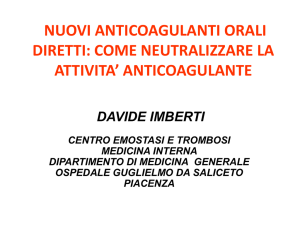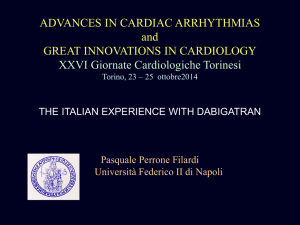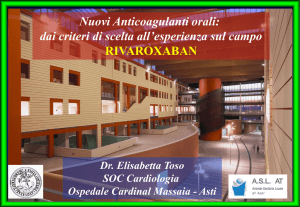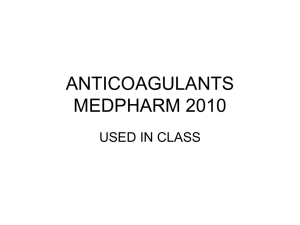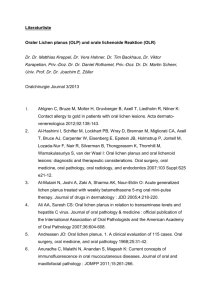New Oral Anticoagulants
advertisement
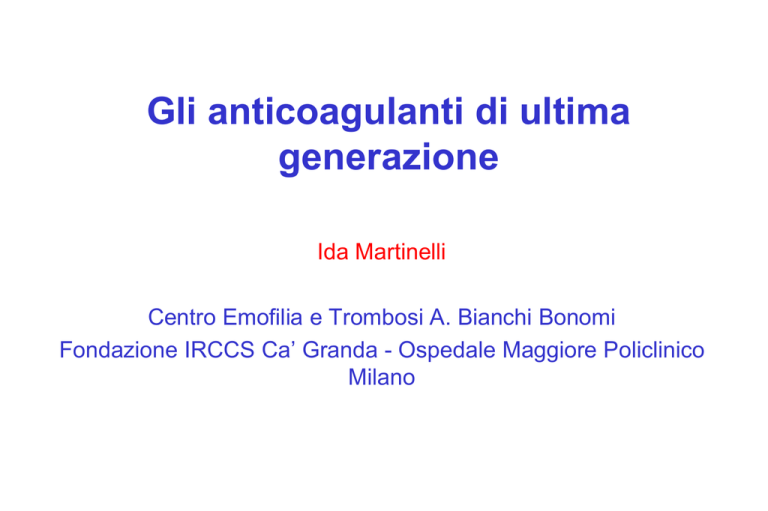
Gli anticoagulanti di ultima generazione Ida Martinelli Centro Emofilia e Trombosi A. Bianchi Bonomi Fondazione IRCCS Ca’ Granda - Ospedale Maggiore Policlinico Milano THE BURDEN OF THE DISEASE Venous thromboembolism (VTE) is the 3rd most common type of cardiovascular disease VTE causes over 500.000 deaths in Europe and 300.000 deaths in the United States each year Annual deaths attributable to VTE are estimated to exceed the combined number of deaths from breast and prostate cancers, AIDS, and traffic accidents Total estimated cost for VTE-associated care = EUR 3.1 billion per year ACHIEVEMENTS WITH TRADITIONAL ANTITHROMBOTIC AGENTS Heparins (UFH and LMWH) reduce by about 60% the incidence of venous thromboembolism (VTE) after high-risk surgery Vitamin K antagonists reduce by more than 90% VTE recurrence Vitamin K antagonists reduce by about 60% the rate of stroke in patients with atrial fibrillation or artificial valves Aspirin and clopidogrel reduce by about 50% the rate of stent thrombosis LIMITS OF TRADITIONAL ANTICOAGULANTS Slow onset of action (warfarin) need for bridging Need for laboratory monitoring (unfractionated heparin, warfarin) Need for parenteral administration (heparins) Non-hemorragic adverse effects, such as heparin induced thrombocytopenia, osteoporosis (heparins) LIMITS OF TRADITIONAL ANTICOAGULANTS Interindividual variability in dosing requirements (warfarin) Food and drug interactions (warfarin) Reduced synthesis of all vitamin-K dependent proteins (risk of skin necrosis in protein C or S deficiency) (warfarin) New anticoagulants TFPI (tifacogin) NAPc2 TTP889 TF/VIIa IX X VIIIa IXa Oral - DIRECT Rivaroxaban Apixaban Edoxaban Betrixaban YM150 Va Xa Oral – DIRECT Dabigatran II IIa Fibrinogen APC (drotrecogin alfa) sTM (ART-123) Fibrin Parenteral - INDIRECT Fondaparinux Idraparinux Biotinylated idraparinux ULMWH adapted from Bates Br J Haematol 2006 New Oral Anticoagulants: pharmacologic properties STEPS OF CLINICAL EVALUATION OF NEW ORAL ANTICOAGULANTS First prevention of VTE in major orthopedic surgery Second treatment of VTE Third atrial fibrillation, acute coronary syndromes Phase III Randomized Controlled Trials of New Anticoagulants for VTE Prevention CUMULATIVE RESULTS OF PHASE 3 TRIALS IN VTE PREVENTION IN HIGH-RISK ORTHOPEDIC SURGERY Oral dabigatran, rivaroxaban and apixaban, given once daily starting after surgery, are at least as effective or more effective than subcutaneous enoxaparin in patients undergoing high-risk orthopedic surgery REgulation of Coagulation in major Orthopaedic surgery reducing the Risk of DVT and PE Lassen et al, N Engl J Med 2008:358; 2776 Efficacy: Total VTE (primary endpoint) RECORD 1 Rivaroxaban 10 mg RECORD 2 RECORD 3 Enoxaparin 40 mg POOLED ANALYSIS OF RIVAROBAXAN IN VTE PROPHYLAXIS More than 10.000 patients studied in 4 randomized trials 56% reduction in symptomatic VTE and mortality No increased risk of bleeding Phase 3 Clinical Trials of New Oral Anticoagulants (vs. Enoxaparin) in Total Hip Replacement (THR) and Total Knee Replacement (TKR) RECORD-1 RECORD-2 Rivaroxaban RECORD-3 (Xa inhibitor) RECORD-4 RE-NOVATE (220 mg) RE-NOVATE (150 mg) Dabigatran RE-MODEL (220 mg) (thrombin inhibitor) RE-MODEL (150 mg) ADVANCE-1 Apixaban ADVANCE-2 (Xa inhibitor) - 15 - 10 -5 0 5 Absolute risk difference (%) 10 15 Phase III Randomized Controlled Trials of New Anticoagulants for Indications Other Than VTE Prevention RE-COVER N Engl J Med 2009 RE-COVER, N Engl J Med 2009 EINSTEIN N Engl J Med 2010 EINSTEIN, N Engl J Med 2010 EINSTEIN-PE, N Engl J Med 2012 Dosi validate in studi di fase III (mg/die) Dabigatran (Pradaxa) Profilassi TEV (chirurgia e medicina) Rivaroxaban (Xarelto) Apixaban (Eliquis) 10 x 1 2,5 x 2 20 x 1 5x2 15 x 2 (prime 3 sett) poi 20 x 1 In corso 150 x 1 Oppure 220 x 1 110 x 2 FA Oppure 150 x 2 Terapia del TEV 150 x 2 New Oral Anticoagulants - ADVANTAGES New Oral Anticoagulants - CONCERNS Unproven compliance in daily clinical practice More expensive than warfarin Unknown safety after years of administration New Oral Anticoagulants - CONCERNS Contraindicated if renal or liver insufficiency Difficult to be detected in patients plasma in case of emergency No antidote Caution when combined with ASA Personal opinion “Fixed” doses are not always better for any patient Phase IV independent clinical trials are needed (risks and benefits in daily clinical practice and in patients excluded from phase III trials)
